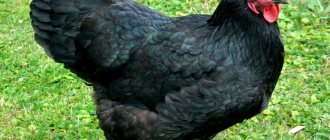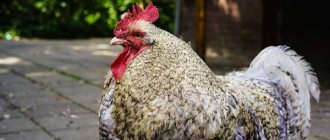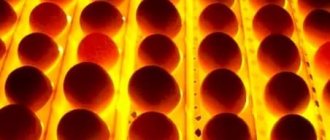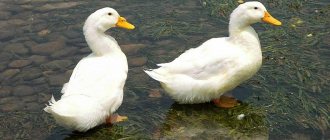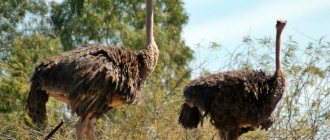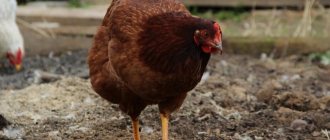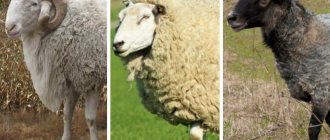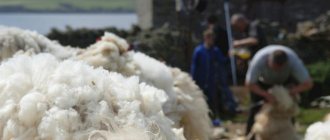Home » Articles about chickens » Breeds of red chickens
Many chickens of national selection have red plumage. Subsequently, breeds and crosses were developed on their basis - breeders achieved improvements in the initial characteristics of the parent generation.
Hungarian giant
Red chickens of this breed were bred in Hungary. They are well adapted to different climatic conditions and have an exterior characteristic of the meat and egg direction. Their body is massive and round in shape. The chest is powerful, the back is wide. The hips are large, the paws are unfeathered. The tail is raised almost vertically. The wings are pressed tightly to the body. The neck is long. The head is small, with a poorly developed red crest and round light lobes. The feather cover is lush, “foxy” (another name for the breed is foxy chick). On the wings and back the color is more saturated than on the rest of the body.
Hungarian giants quickly gain weight - at 3-4 months, excess roosters can be sent to slaughter. By this age they fatten up to 2.5 kg. Adults weigh 4-4.5 kg. Laying hens lay up to 200 eggs weighing 55-60 g throughout the year. Sexual maturity occurs at 4.5-5 months.
Prospects for poultry farming
The growing need of the planet's population for food remains the most powerful incentive to continue breeding work. Modern egg breeding breeds are capable of producing more than 200 eggs in the first year of life. Such successes have been achieved since the twenties of the last century, when, in fact, the targeted breeding of chickens for productive specialization began.
During this time, more than a hundred breeds of chickens for egg, meat, decorative or universal purposes were bred. Today, geneticists are faced with the task of not only maintaining the high egg production of chickens, but also ensuring the quality of the product itself. Pay attention to:
- shell strength;
- egg composition;
- egg weight.
New technologies for keeping poultry are being developed. Work is underway to optimize the composition of feed for laying hens. This will make it possible to obtain eggs with the specified parameters for the qualitative and quantitative content of certain nutrients.
Despite the diversity of breeds, breeders around the world continue to work on developing new lines and crosses. Particular emphasis is placed on crosses. It has long been known that when comparing purebred and cross-bred birds, the latter is preferable.
Crosses are more resilient, hardy, more easily adapt to new conditions, resistant to diseases and have higher productivity. They are used in industrial poultry farming, regardless of the type of product produced - eggs or meat.
A bird that has been close to humans since ancient times and has undergone a huge number of selection changes over many centuries. Chicken, it is impossible to imagine a modern farm without it. And no kitchen in the world can do without eggs and meat.
Wyandotte red
Chickens with red plumage are one of the varieties of Wyandottes. The birds were bred in America. Their feather cover is elegant - red feathers are bordered by a thin black stripe. The predominant color in the tail is black, this is especially noticeable in males. The body is powerful, with a thick neck, strong legs, and short wings. The weight of roosters is 3.4-3.8 kg, hens - 2.5-3 kg. Egg production – 180-200 pcs.
Let's summarize:
In order not to regret the chosen breed and profitability, first study all the egg-bearing breeds presented, choose the best option that will not contradict your aesthetic perception of the outside world. Advice from an experienced farmer will not be superfluous.
Each of these breeds of laying hens is special and you will love and learn to get along with each of them. Your farm will receive a new rainbow of colors thanks to the uniqueness of winged birds.
Good luck in choosing corydalis, dear poultry farmers!
Yerevan red
Yerevan chickens are a universal breed, originating from New Hampshire and Rhode Island. Meat productivity – up to 2.7 kg (females) and up to 3.5 kg (males). Egg production – 160-180 pcs. in year. In the first year, productivity is low, but gradually it increases to the specified levels. The exterior is standard. The body has a triangular shape. The back is short, the legs are fleshy, the chest is wide. The neck is long. The head is medium size. The comb is leaf-shaped. The plumage is red-brown, the tail is black.
Secrets of care
It's no secret that performance indicators depend not only on the genetic potential of the bushes
It is very important how the most egg-laying chicken breeds feed and in what conditions they live. Below we will look at a few secrets that will help you unlock the full productive potential of your herd.
- Provide nutritious meals three times a day. The menu should be balanced and varied. During the period of activity, the need for calcium and proteins increases.
- Use premix additives that stimulate egg laying. But, do not overdo it, so as not to provoke vitamin deficiency.
- Try to organize your family life in such a way that there is no room for frequent stress that disrupts the stable cycle.
- Add fat-containing foods and sources of animal protein to your meals.
- Use flaxseed to improve your performance.
- Observe the light regime - this is the key to success.
- Keep it clean and warm to ensure the hens lay consistently.
Don't miss out on new products - subscribe to site updates to always be the first to read the latest publications!
Wish you all the best!
See modern products for poultry and livestock farmers that improve the health of pets and make our work easier.
Kuban breed
Red laying hens of the UK Kuban-7 breed are birds with a stocky build, short neck, and medium-length legs. Their feather cover is hard, dense, with a large layer of fluff. The head is small, the crest and earrings are highly developed. The skin on the face is red and there is stubble. Hens are fattened up to 2.5 kg, roosters – up to 3 kg. Egg production – up to 320 pcs. in year.
Historical reference
Since ancient times, on farms and private farmsteads, the most common village chickens were most often a reddish-red or white hue. Autochthonous or folk breeds were highly valued because over many years of breeding in a certain area they developed adaptation mechanisms and insensitivity to climatic conditions. The only drawback of such varieties was low productivity.
Red chickens
But, with the development of breeding science, improved, productive breeds began to appear based on existing local red chickens. Today they are presented in 2 categories:
- breeds;
- crosses.
Important information! Crosses are a genetically unstable variety, and their breeds are the opposite - they are capable of producing offspring with the same breed characteristics when bred "in themselves."
Red whitetail
The breed was bred in England. The body is wide and short. The chest is convex, the legs and thighs are well developed. The head is small, the skin is reddish. The ridge is highly developed and leaf-shaped. The earrings are round. The earlobes are white. The plumage is mostly red, with a gradation of shade, only the tail is light, creamy-white, with a reddish border. The weight of adults is 3.5-4 kg. Egg production – 170-200 eggs, depending on the quality of feeding.
Individual record holders
Achieving your own records for raising birds has gained popularity for a very long time. Today, many chicken owners compete with each other, trying to achieve maximum results in order to go down in history. Some just want to share their achievements and give some recommendations to novice poultry farmers.
The largest birds that became famous thanks to their owners and became famous throughout the world are presented:
Little John
This name was given to the Brahma rooster, received from the owner, Jeremy Goldsmith. The giant bird lives in England, Essex. At the age of 12 months, little John was already 66 centimeters tall. It is more likely that by the second year of life the bird will become even taller. The owner does not directly answer what contributed to such a rapid growth of the rooster, but hints that he prepares a special diet for the pet.
Jeremy Goldsmith allows the kids to come in for rooster inspections, and doesn't even mind being fed chips and popcorn.
Big Snow
This nickname was given to the officially registered record rooster in the heavyweight category. The bird belonged to Australian Ronald Alldridge, originally from Queensland. The registration date of the rooster was in 1992, at that time the bird’s weight was 10.36 kilograms, its withers reached a height of 43.2 centimeters, and its chest circumference was 84 centimeters.
The bird breed is quite rare - Whitesulli. Representatives can reach a weight of 8-10 kilograms. The owner of the animal was very proud of his pet, as evidenced by many photos with celebrities, which also depicted Big Snow. In the fall of the same 1992, the bird died of natural causes.
Rooster Coburn
Record holder from the Brahma breed, lives in the UK. His interesting name was given to him in honor of the main character of the American film True Grit. The giant weighs 11 kilograms and is 91 centimeters tall. The owners of Rooster Coburn are a married couple - Mr. and Mrs. Stone. They claim that the bird is a real guard of its chicken coop, because it does not even allow foxes to approach it.
Red Star
Red egg breed chickens were bred in America. The weight of adult individuals does not exceed 3.5 kg. Over the course of a year, laying hens lay 250-280 pieces. weighing 70 g. Under good conditions, you can count on 300 eggs. Sexual maturity occurs at 4-5 months. Delaware and Rhode Island were used in the selection. The exterior is unremarkable, the crest is small, the tail is slightly raised. The color is light red. There are white inclusions.
conclusions
In homestead livestock farming, chickens of egg breeds are often raised. Among the most productive are Leghorn, Russian White, Highsex, Loman Brown, Kuchinskaya Jubilee. Every 2-3 years, due to a decrease in productivity, chickens are culled, and the poultry farmer buys replacement young stock. To select egg-laying chickens for further use, you need to pay attention (especially to beginners) to the following exterior signs of high productivity:
- The correct distance between the pubic bones should be at least 3 fingers of an adult’s hand.
- Volumetric and soft belly.
- Brightly colored and elastic comb and earrings.
- Yellow pigmentation of legs, iris, beak. In the fall, it is paler in highly productive chickens.
- Shedding. Good layers molt in mid-autumn.
- Plumage. In a healthy and highly productive bird, it is shiny and tightly adjacent to each other.
You can read about why chickens go bald here.
Maran black-copper
This breed of black and tan chickens is of French origin. The bird's body is black, the neck and head are red. There are patches of colored feathers on the chest. Roosters have bright plumage on their backs and wings. The birds are large, with dense dense feather cover. The comb is fleshy, large, and can be tilted to one side. The weight of females is 2.5-3 kg, males – 3.5-4 kg. Number of eggs – 150 pcs. in year. The peculiarity of marans is their very dark, chocolate-colored egg shells.
Dominant
Numerous crosses bred in the Czech Republic. Includes several varieties of chickens that differ in color, egg shell color and direction of productivity.
Characteristic:
- Egg production (per year): 280-320 pcs. (60-70 g).
- Color of testicles: brown in different shades, cream, blue, green.
- Laying hen weight: 2 kg.
- When they start laying eggs: 120-150 days.
Farmers more often keep grey-speckled, black, blue and silver dominants on their farms. Dominant hens begin to lay eggs early and the eggs are large. The peculiarity of the cross is its demands on the composition of the feed mixture. With a lack of protein and calcium, egg production decreases.
IMPORTANT: when breeding, the egg production of young animals will be much lower, since this is a typical cross.
New Hampshire
The chickens are large, with red plumage and black tail feathers. The body is oval. The neck is covered with a beautiful feather collar. The tail of roosters is lush, raised 45 degrees in relation to the back. In chickens it is small and slightly raised. The comb is fleshy, leaf-shaped. Females weigh 2.1-3 kg, males - 3.25-3.75 kg. Egg production – 200 pcs.
Features of caring for adult hens and Hisex chicks, their breeding
Despite the unpretentiousness emphasized in reviews by all farmers regarding crosses of the Hisex chicken breed, keeping chickens has some peculiarities. For their successful development and reducing the mortality rate of livestock, it is necessary:
- Ensure the temperature of the room for young animals is 22°C, if necessary, install infrared lamps and heating devices in the chicken coop
- Avoid overheating of young chickens, which occurs at a temperature of 25-28°C, since when it occurs, fatigue and a decrease in motor activity are first observed, after which immobility occurs, and as a result, there is a high probability of death of the young.
Despite good compatibility with other species, in order to prevent damage to common avian diseases and infections, including staphylococcus, pullorosis, brucellosis and salmonellosis, timely vaccination and separate keeping of chickens are recommended.
Conditions of detention
As noted above, the characteristics of the breed practically exclude the cellular content of Highsex. If the breeder nevertheless decides to resort to this method of keeping, it should be noted that there should not be more than 2-3 individuals in the cage. It must have good lighting, a heating system, feeding, watering, collecting eggs and be equipped with the necessary means of maintaining microclimate parameters and protection from predators and rodents.
The floor-based method of keeping hens, which is more common for individual farms, despite the unpretentiousness of laying hens, should include:
- Necessary indicators of personal space, providing for a lower stocking density in relation to conventional breeds of chickens and equipping the chicken coop with a sufficient number of perches and a container with wood ash and sand to prevent the appearance of parasites.
- The optimal temperature should be maintained in the range of 15-20°C; it is undesirable to allow it to drop below 12°C.
- The required length of daylight hours, which should be about 10 hours.
- The chicken coop must be equipped with an air ventilation system, containers for collecting eggs, and a separate area for walking chickens.
Dryness, shaking and changing the litter as it gets dirty, taking recommended preventive measures to prevent the appearance of insect pests and pathogenic microflora.
Diet
For the full development of chickens and obtaining Highsex chickens with a high degree of productivity, experienced farmers advise adhering to the nutritional system and the following recommendations:
- Feeding chicks at the age of several weeks should begin with a mixture of chopped greens and boiled eggs.
- During this period, it is recommended to replace the water in the drinkers with heated milk; the freshness of the milk is a prerequisite, since a spoiled product can cause disease in the chicken’s gastrointestinal tract.
- As the chicks grow older, it is necessary to include in their diet parts of vegetables and fruits cut into large pieces, mixed feed, mash based on water and corn flour.
- Feeding adult laying hens should include systematic additions of balanced mineral and vitamin supplements, legumes, nettles, vegetables, coal and chalk.
When entering the age of active egg-laying, the basis of the feed ration is compounded feed, which, in the opinion and reviews of some breeders, is one of the disadvantages of the breed. Other farmers claim that the costs are more than compensated by the high productivity of the hens.
Video: Hisex Brown - arrangement of a winter chicken coop, its heating and feeding features
Breeding specifics
The difficulty of breeding Hisex chickens is that when crossing with other breeds, traits are not inherited.
In this regard, to update the livestock, it is necessary either to promptly purchase pullets from trusted suppliers, or to use high-quality eggs obtained from poultry farms.
Video: Hisex cross chickens
Oryol scarlet
This ancient Russian breed was bred on the basis of fighting chickens. The birds are hardy, well adapted to frost. The body of roosters is almost vertical, hens are squat, with a horizontal body position. The back of the head and neck are covered with lush plumage, and there are sideburns on the head. The comb is small. Scarlet feathers are one of the color options. The brown-breasted and black-breasted subspecies have been bred. Meat productivity – 2.2-3.1 kg. Number of eggs – 145 pcs. in year.
How to choose meat chicken?
To get tasty and juicy meat from your chickens. you need to choose the right individuals. To do this, please read the information below.
What to pay attention to:
- the bird should have widely spaced legs;
- the plumage of a meat breed should not be very thick;
- the body of the bird must be horizontal;
- the bird should have calm behavior without signs of anxiety.
Having chosen a suitable meat breed for yourself, strictly control the amount of food it eats. Such birds are prone to obesity.
Orpington red
The red subspecies of the breed was bred in Germany on the basis of yellow Orpingtons, red Rhode Islands and Sussexes. The birds are large, with a straight back, thick neck, strong legs, and scanty red plumage that fits tightly to the body. They are hardy and can withstand heat and cold well. The live weight of chickens is 4.5-5.5 kg, of roosters - 5-7 kg. Number of eggs per year – 160-180 pcs. Hatchability: 93%.
Features of feeding laying hens
To obtain high egg production, the bird's diet must be balanced and contain the required amount of proteins, fats, carbohydrates, vitamin and mineral supplements.
There are three types of food for birds. These are dry, wet and combination.
Dry feed includes compound feed, which is produced in accordance with GOST. The feed contains grain mixtures, vitamins and microelements necessary for laying hens.
- The grain mixture consists of corn, wheat, and oats. Corn gives the bright yellow color to the yolk and is a source of carotene. Wheat is the main source of protein and vitamin E, B. Sprouted wheat is considered beneficial. Oats contain sodium, magnesium, calcium, potassium and iron and a large amount of amino acids.
- Sunflower, flax and legumes are added to increase egg production.
- Birds need an additional source of calcium to keep their shells strong. To do this, the diet includes chalk, shell rock, limestone, and salt.
- Homemade mash is a wet food type. Cake, flour, boiled potatoes, vegetables, herbal flour are mixed and filled with water or dairy products. It is not recommended to prepare the mixture in large quantities, as it quickly turns sour.
Experienced poultry farmers recommend a combined type of feeding, using dry mixtures and mash.
The diet of laying hens must be supplemented with green feed. When walking, the bird replenishes its supply of fiber, vitamins, and minerals. In winter, green grass is replaced with hay and root vegetables.
River sand is given to improve digestion.
Rhode Island red
Rhode Island Red chickens were bred in the USA based on five breeds. The bright color of the feathers is characteristic of one of the subspecies. The bird's body is rectangular, set horizontally. The back is wide, long, the chest is convex, the wings and tail are small. Legs are strong. The main color of the plumage is red, the color on the legs is lighter. The flight and tail feathers are painted black. The weight of roosters is 3.5-3.8 kg, chickens are 2.7-3 kg. Laying hens lay 160-170 eggs per year. Vitality is high. Sexual maturity is reached at 7 months.
Hamburg
An ancient breed that originates in Holland, but it was recognized in the German city of Hamburg. Local chickens were used to obtain it. They are often kept as ornamental, but at the same time they show good egg production.
Peculiarities:
- Egg production (per year): 175-250 pcs. (45-55 g).
- Testicle color: white.
- Laying hen weight: 1.8 kg.
- When they start laying eggs: 120-150 days.
Small chickens with an attractive appearance. They need a large enclosure with a closed top, as they fly well. The colors are divided into two groups: speckled (golden, flesh to tan, silver and lemon with black speckles) and edged (golden and silver).
INTERESTING! There are also black and white chickens. The comb is pink, the lobes are white.
Shumavskaya
The Czech breed of red chickens is called Šumava or Šumava. Hens are fattened up to 3-3.1 kg, roosters – up to 3.5 kg. Puberty occurs at 5-6 months. Egg productivity – 180-200 pcs. in year.
The physique is proportional. The body of males is elongated, with a protruding chest. Females are more stocky. The thighs and legs are well developed and fleshy. The neck is long. The head is small, the crest is fleshy, low, and nut-shaped. The beak and paws have a grayish tint. The tail is high. The color of roosters is red-brown, females are lighter.
A little history
As you know, people did not immediately domesticate chickens and began to raise them on their farms. Initially, many species were wild, living and breeding in natural conditions.
To date, scientists cannot answer when exactly people figured out how to make useful domestic animals out of chickens. But this only means that domestication occurred quite a long time ago, and that is why no records of the first chicken breeders have survived to this day.
Breeds today are classified by type. The most popular are egg, meat and meat-egg. In addition to these birds, there are also decorative and fighting birds.
Among the varieties known today, only a small part is considered natural - the remaining breeds of white laying hens were obtained through selection at different times. Chickens with light feathers are also, for the most part, the result of the work of breeders.
Tetra
The breed is fast growing - already at 4.5 months the weight exceeds 2 kg, adult individuals fatten up to 2.6-3 kg. Birds have a long body. Roosters look fit, chickens have a round belly. The head is small, with an erect leaf-like crest. The color of the roosters is red, the hens are lighter. The first clutch occurs at 4-6 months. Over the course of a year, birds lay up to 300 eggs with brown shells. Average weight 1 pc. – 60 g.
Characteristics of egg-laying chickens
When choosing a quality breed of laying hens, you need to take into account that most of them are not suitable for meat. Birds of both sexes weigh little and mature early. Females begin laying eggs at 4 months. In “meat” chickens this occurs from 7 months.
When breeding laying hens, experts do not pay close attention to the volume and quality of meat, taking into account only the indicators of eggs.
A breed can be called an egg-laying breed if:
- The weight of a cockerel is within 3 kg, and that of a hen is from 2 to 2.2 kg.
- Birds are restless. They are very active and mobile.
- Chickens have a high appetite because they require constant feeding. Normally they produce 1 egg in 25 hours. To restore the expended energy and calories, the female needs food.
The egg production of any chicken is directly related to the number of eggs. This property manifests itself even in the chicken and does not change until the end of the bird’s life. Oviparous females can have up to 4 thousand eggs, this is a variant of the norm. But it does not follow from this that one individual can lay so many eggs. After all, a laid egg can be fully realized in 15 years, and most birds do not live that long and are not kept on the farm.
Peak egg production of all varieties occurs at 3-4 years of life. After this, the females become less productive, so the factories discard them.
On average, commercial egg-laying hens should produce 220 eggs per year. But there are also records. For example, a female Leghorn produced 361 eggs.
Where can I buy?
Today, breeders have more opportunities to purchase poultry than before. Without any problems, you can order incubation material from another country, and it will be delivered safe and sound. In addition, you can buy chickens anywhere. But they don’t always grow into what was expected.
Therefore, when purchasing, follow several rules.
- If you purchase material for incubation, inquire about the storage conditions.
- Under no circumstances buy chickens from the list of red breeds of chickens “from your hands” in spontaneous markets. Hypothermia and improper transportation will negatively affect the health of the cubs.
- Give preference to trusted suppliers with a good reputation.
That's basically it! Help your friends make their choice - share the material you read with them on social networks. Don't forget to subscribe to updates to be the first to read new articles about winged beauties!
We wish you good mood and success!
Did you like our tips? Share with friends on social media. networks!
